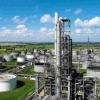|
|
Kero/gas Oil Stripper Heat Balance
#1

Posted 20 July 2008 - 05:10 AM
One my friend ask me during discussion for Steam stripper heat balance; I was confused to reply for his question.
Column Condition is:
Feed Inlet:170^0C at tray one
Steam Inlet:200^0C Bottom Tray 17
Column top pressure:6.2barg
Receiver:Partial
no additional Heat in put:no
Bottom Temp:168^0C
Question:
1=Difference between feed inlet and steam temp is 30^0C, but in column temp profile not indicating any temp change, why?
2=OH liquid product again mixing with feed, why?
3=There is no reflux, the feed is going on tray one, what is this philosophy, why no reflux is given.
I will highly appreciate you, for in detail answers.
Thanks
Toor
#2

Posted 20 July 2008 - 12:38 PM
1. The heart of steam stripper operation is reduced partial pressure of hydrocarbons in kero/gas oil, when steam is introduced at the bottom of the tower. Lighter fractions are simply forced to evaporate at these conditions. Latent heat of evaporated hydrocarbons comes from the sensible heat of kero/gas oil (and not from the steam!), so in all strippers bottoms product temperature should be lower than the feed temperature. Subcooled product is a sign of efficient stripping. Heat balance is:
Mass flow of stripped HC * Latent heat = Mass flow of stripped product * Heat capacity * Delta T
2. I can't see any reason for mixing overhead liquid product with the stripper feed, since it loads the stripper without any practical reason. If this is kero/gas oil Hydrotreater unit, this liquid stream is usually sent to gas concentration unit where it ends up in naphtha fractions. In crude distillation units, stripper overhead vapor is returned to the main column, 2-3 trays above the stripper feed draw-off tray. However, depending on refinery configuration, one could be forced to recycle this stream to the stripper inlet.
3. As I wrote at the beginning of this post, there is no need for reflux when feed is introduced at the top tray. All steam strippers I have seen function in the same way.
Your stripper deltaT is unusually low, indicating poor stripping or (already) subcooled feed which adversely affects stripping operation.
#3

Posted 25 April 2011 - 09:22 AM
As you have mentioned, the Latent heat of evaporated hydrocarbons comes from the sensible heat of kero/gas oil (and not from the steam!) - which also means that there is a linear relationship between the percent vaporized and the temperature drop across the stripper. In the APC (Advanced Process Control) used in our refinery (we have all the control variable on one side and manipulated variable on the other side in the screen), in the control variable column I observed that we are controlling the ratio of the amount of kero withdrawn to the amount of steam used over a particular range; e.g., from 5 to 12. My question is: is that an indirect way of optimizing the stripper efficiency?
#4

Posted 26 April 2011 - 02:41 PM
I forgot the reference, but I will try to express it by words: if you plot a chart showing % percent vaporized fraction vs. steam-to-Kero ratio (kg/m3), you will see a typical log chart shape, where the amount of vaporized hydrocarbons from Kero becomes basically flat line - meaning that using extra steam will not remove further any fraction from Kerosene liquid.
Someone has probably done the economics in your refinery, in the sense of comparing cost of steam vs. increased Naphtha yield (coming from Kerosene), while having Kero flash point (or IBP) as a constraint, and that has resulted in having an "optimized" ratio of steam vs. Kero draw-off rate.
#5

Posted 27 April 2011 - 10:23 AM
#6

Posted 27 April 2011 - 04:18 PM
What is the target, and what are the constraints of your Kero/Steam control loop?
#7

Posted 27 April 2011 - 11:59 PM
Dear Zauberberg
As you have mentioned, the Latent heat of evaporated hydrocarbons comes from the sensible heat of kero/gas oil (and not from the steam!) - which also means that there is a linear relationship between the percent vaporized and the temperature drop across the stripper. In the APC (Advanced Process Control) used in our refinery (we have all the control variable on one side and manipulated variable on the other side in the screen), in the control variable column I observed that we are controlling the ratio of the amount of kero withdrawn to the amount of steam used over a particular range; e.g., from 5 to 12. My question is: is that an indirect way of optimizing the stripper efficiency?
Hi,
There is no relation for stripper optimization with kero draw, stripper fuction is to control the IBP and remove lighters, 'ie' H2S and other light hydrocarbons. Steam to stripper column depend on sulphur component in product not on based on kero draw.
Kero draw you can make estimated based on feed analysis.
Toor
#8

Posted 16 August 2011 - 02:51 AM
I agree with all the given answers to your question. I would like to add something though. You state that the top pressure is 6.2 barg. That means that the top pressure is 7.21 bar absolute and with a typical pressure drop per tray of 7 mbar, the bottom pressure would be 7.33 bar absolute. At this pressure, steam condens at about 167 C, which is scaringly close to your reported bottom temperature of 168 C. I have seen water condesnation due to too low inlet temperatures in two of our strippers. It might very well be that you get say 2% vaporization of the kero and then the kero is so cold that any incremental steam will simply condense and give free water in the bottom of the stripper. I would suggest that you try to increase the rate of stripping steam to the stripper. If delta-T does not increase with increasing steam rate, free water is probably formed in the tower.
Regards
Hansson
Similar Topics
Steam Pressure In Heat ExchangerStarted by Guest_mvanrijnbach_* , 15 Apr 2025 |
|

|
||
Material Balance With ReactionStarted by Guest_Kentucky08_* , 30 Apr 2025 |
|

|
||
Heat Exchanger Steam FlowStarted by Guest_aliebrahem17_* , 25 Nov 2024 |
|

|
||
Discussion - Predict Storage Tank Heat Transfer Precisely By Jimmy D KStarted by Guest_raj shekhar_* , 25 Mar 2025 |
|

|
||
Cross Over Temperature In Countercurrent Heat ExchangerStarted by Guest_panoska_* , 18 Feb 2025 |
|

|

 FB
FB








